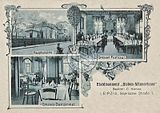House of seven men
The Siebenmännerhaus was a restaurant near the Bavarian train station in Leipzig .
With the completion of the Bavarian train station, for example, a building appeared on Leipzig's plans and images to the west of the train station, the shape of which with two towers of different heights could initially be reminiscent of a church (Fig. 1 and 2). But it was a restaurant, the Siebenmännerhaus. The architectural style was similar to that of the Bayerischer Bahnhof. The address was Bayrische Strasse 1, which is now Arthur-Hoffmann-Strasse. In later pictures (Fig. 3) the towers appear lower.
The house was built in 1845 by a six-man bowling company and sold to an innkeeper in the same year. This probably considered himself the seventh man and gave the house its name.
The restaurant was popular with clubs and student associations at the University of Leipzig (Fig. 4). It is reported that the Roter Löwe Leipzig fraternity gathered here from the 1880s to the 1930s. The Alemannia fraternity also had their restaurant here from 1926 to 1930. The following are also occupied:
- Gymnastics Association Albertia ,
- Academic gymnastics club Alemannia ,
- Country team Franconia ,
- Connection Istaevonia (former legal and political science connection),
- Connection Mecklenburgia ,
- Academic Richard Wagner Society ,
- Catholic Student Association Teutonia ,
- Scientific Catholic Student Association Unitas ,
- Academic-theological association Vitemberga .
In 1899, Russian students founded the Russian Academic Association at Leipzig University , which existed until 1914. The Siebenmännerhaus was also one of his club bars. That may well have been the reason why Lenin spoke in the House of Seven in 1914.
In 1935 the (Jewish) sports club Schild Leipzig (part of the sports association of the Reich Association of Jewish Front Soldiers) was able to hold a social get-together with around 300 participants in the Siebenmännerhaus.
The Siebenmännerhaus was destroyed in a bomb attack on Leipzig during World War II. The area was not built on again and today partly forms the green area at the Bayerischer Bahnhof.
(1) Bayerischer Bahnhof area on a bird's eye view of Leipzig 1847
See also
literature
- Helmut-Henning Schimpfermann : Gastronomy on the Pleiße. Verl. Die Quetsche, Hanau 1991, ISBN 3-9802743-0-6 , p. 106.
Individual evidence
- ↑ Harald Lönnecker : Der Rote Löwe zu Leipzig , Frankfurt am Main 1993, p. 10. ( online ; PDF; 149 kB)
- ↑ Official Academic Inquiry Point Leipzig (Ed.): Directory of student associations and associations of the University and Commercial College Leipzig , 6th edition, October 1924, Verlag von Alfred Lorentz, Leipzig
- ↑ a b Gunnar Auth (Ed.): Alemannia is Panier! Old Leipzig Alemanni remember their fraternity (1861–1935). BoD, Norderstedt 2006, ISBN 3-8334-5068-1 , p. 96.
- ↑ a b File in the Leipzig University Archives.
- ↑ a b c German university calendar, winter semester 1922/23, Verlag Johann Ambrosius Barth, Leipzig.
- ↑ a b c E. H. Eberhard (Ed.): Handbook of the academic associations at the German universities , Verlag von KG Th. Scheffer, Leipzig 1904.
- ^ Bookstore Gustav Fock (ed.): Leipzig University Calendar , winter semester 1906-07.
- ↑ Dieter Kürschner: Mind Journeys to Russia and the USSR , In: Leipzigs Neue , Heft 6 (2011), p. 19.
- ^ Siegfried Beckert: When Lenin once spoke in the seven-man house in Leipzig. - A little-known episode from February 1914 , In: Neues Deutschland , 1978, No. 18, from January 21, 1978, p. 15. ( reference )
- ^ Nils Havemann: Football under the swastika: The DFB between sport, politics and commerce. Campus, Frankfurt am Main 2005, ISBN 978-3593379067 , p. 273.
Coordinates: 51 ° 19 ′ 45.2 " N , 12 ° 22 ′ 49.2" E



